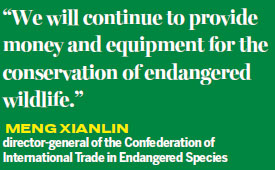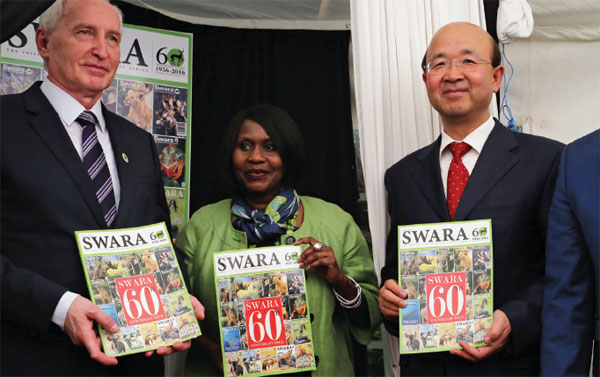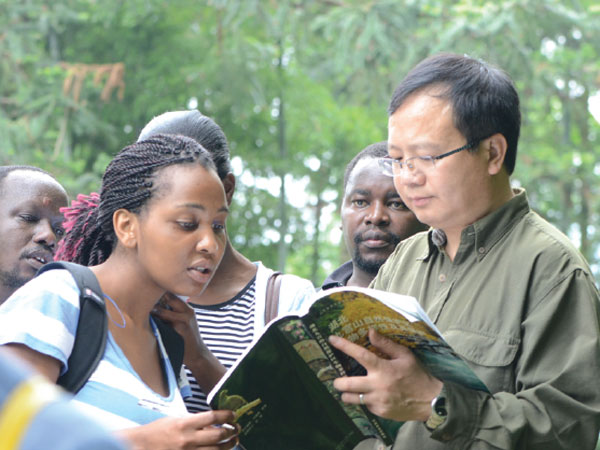Preserving Africa
China plays a major cooperative role in protecting biodiversity, starting with its ban on the ivory trade
As Africa gears up to preserve its flora and fauna - species on the verge of extinction because of the illegal wildlife trade, overpopulation, over-exploitation and increased infrastructure development-China has proved to be a key partner.
The Asian powerhouse, has been engaged in various collaborative initiatives with African countries, from financing to equipment donation and helping the continent to preserve its heritage.

|
From right Liu Xianfa, Chinese ambassador to Kenya, Judi Wakhungu, Kenya's cabinet secretary in the Ministry of Environment and Natural Resources and Lain Douglas, the founder and senior scientist, Save the Elephants, at the 60th anniversary ceremony of EAWLS. The Chinese government has been helping EAWLS to publish the quarterly conservation publication. Edith Mutethya / China Daily |
|
Chinese Ambassador to Kenya Liu Xianfa, plants a tree to mark the launch of the Sino-Africa Joint Research Center at the Jomo kenyatta University of Agriculture and Technology in September, 2016. Liu Hongjie / China Daily |
One of the notable initiatives is China's ban on the domestic ivory trade. This has given many African countries hope, since China is the largest consumer of ivory in the world, followed by the United States, according to a study by British conservation group Care for the Wild International.
Judi Wakhungu, the Kenyan Cabinet secretary for environment and natural resources, lauds the move, noting that wildlife poaching and trafficking are economic crimes that pose threats to the economies of many African nations.
"I applaud the government of China for the bold and encouraging move to close its domestic legal market for ivory by the end of the year," she says.
Julius Kamau, executive director of the East African Wild Life Society, says the move to ban the ivory trade offers a glimmer of optimism in the fight against elephant poaching.
"We have been advocating for a ban on the ivory trade for some time now; so we are happy about the initiative by the Chinese government. We hope poaching activities will be reduced significantly," he says.
According to a survey by the World Wildlife Fund published in November, around 20,000 elephants are killed in Africa annually for their tusks. Additionally, the African tourism sector loses around $25 million (22.2 million euros; £19.4 million) annually as a result of elephant poaching.

During the recent 56th session of the Asian African Legal Consultative Organization in Nairobi, Kenya, Meng Xianlin, director-general of the Confederation of International Trade in Endangered Species, or CITES, in China assured African government leaders and conservationists that China was not only committed to banning ivory trade in its domestic market but also supports African countries' efforts to preserve their wildlife.
He noted that 12 factories and 55 outlets had already been closed and the remaining 22 factories and 88 outlets will be shut down by the end of the year.
Additionally, Meng said, reminder messages have been sent to all Chinese citizens traveling abroad to dissuade them from illegal hunting, purchasing or carrying of wildlife or wildlife products.
"We will continue to provide money and equipment for the conservation of endangered wildlife, including African elephants," he said.
His organization has also been inviting officers from African and Asian countries to China for CITES training in policy implementation, wildlife management and law enforcement.
Creating legal framework
Sikhumbuzo Zondi, research assistant at the University of South Africa's Institute for Global Dialogue, says the Chinese government has been making tremendous efforts to improve the legal framework of wildlife protection by strengthening the management system and law enforcement on the continent.
He adds that China has been at the forefront in conserving Africa's wildlife by strengthening cooperation through CITES.
CITES promotes training programs and offers financial and technical support to countries including Kenya, South Africa, Zimbabwe and Botswana, which have been hardest hit by the illegal wildlife trade.

"The Chinese government in its bid to combat the domestic trade in ivory summoned its corporations that are engaged in wildlife operations to contribute $200,000 to the African Elephant Conservation Fund. This clearly demonstrates China's commitment to combating elephant poaching and the domestic trade in ivory," Zondi says.
Since 2013, China has participated in an international crackdown on wildlife crimes through an effort called Operation Cobra, which involves 22 countries in Asia and Africa. Since its inception, more than 200 cases involving the smuggling of threatened species have been solved, and more than 100 suspected poachers have been detained. Around 6.5 tons of ivory has been seized.
"All these efforts demonstrate China's serious commitment to fighting poaching," Zondi says. "It also means that African countries that are hardest hit by illegal wildlife trade will experience profound effects in their elephant conservation and anti-ivory trafficking efforts. This is because cutting consumer demand for wildlife products in China could essentially prevent the loss of Africa's last elephants to poaching."
Palamagamba Kabudi, the Tanzanian minister for justice and constitutional affairs, says the country has been collaborating with the Chinese embassy in Tanzania on various initiatives aimed at preserving wildlife.
He cites the Walk for Elephants campaign, launched in 2014 by the Tanzanian government in collaboration with the Chinese embassy and the Tanzania-China Friendship Promotion Association.
The campaign aims to pressure the government to do more to stop the poaching, which is driving elephants to the brink of extinction. It also aims to make Tanzanians and Chinese living in Tanzania aware that protecting elephants requires teamwork.
"We hope that CITES will start participating in the walk in the near future to show the Tanzanians that the Chinese government does not condone the illegal wildlife trade.
Botswana is another country that has greatly benefited from the China-Africa wildlife collaboration. Last year, the Chinese government donated equipment and uniforms valued $1.7 million to Botswana's wildlife authority to support its wildlife protection efforts.
The donation followed another Chinese sponsorship to relocate 500 animals, including 100 eland and 400 wildebeest in the Central Kalahari Game Reserve.
That move was warmly applauded by the government of the southern African country. Botswana has one of the highest conservation land ratios in Africa with more than 25 percent of its land area set aside for parks and reserves to preserve the country's national heritage.
Research is key
In addition to all these efforts, the Chinese government has committed itself to helping Africa carry our research activities - the key to conservation and biodiversity.
To that end, in 2013, the Chinese Ministry of Commerce initiated construction of the Sino-Africa Joint Research Center in Kenya, known as Sajorec.
The project, which was handed over in 2016, is a collaboration between Jomo Kenyatta University of Agriculture and Technology and the Chinese Academy of Sciences.
The research center will serve as a hub for Sino-African cooperation in biodiversity-related research, aiming to solve the continent's challenges. Plants, animals, fungi and microbes are all subjects of study.
Africa has rich biodiversity. Its living organisms, according to the United Nations Environment Programme, account for around one-fourth of global biodiversity; it also supports the world's largest intact assemblages of large mammals.
The continent's biomes extend from mangroves to deserts, from a Mediterranean climate to tropical forests, temperate zones to subtropical and montane grasslands and savannas, as well as ice-capped mountains.
However, the biodiversity has been experiencing rapid and alarming degradation as a result of socioeconomic factors such as overpopulation and over-exploitation.
Researchers meeting in Cameroon in 2014 warned that Africa could lose upto 30 percent of its animal and plant species by the end of the century, owing to global warming, population growth and unregulated development.
The research center, the first of its kind in Africa, aims to help the continent preserve all its diverse lifeforms.
The research center comprises specialized facilities, including laboratories, a her barium, greenhouses, administrative offices, a conference center and hotel facilities. African and Chinese scientists will jointly carry out research at the center mainly focusing on biodiversity conservation, geographic and remote sensing, natural products development, agricultural science and technology, microbiology and molecular biology.
The CAS has completed the installation and commissioning of scientific equipment, and the laboratories are expected to be fully functional by the end of this year.
According to Wang Qingfeng, the CAS director of Sajorec, the center has gathered a group of high-quality scientific research personnel from 18 CAS institutes and 15 science and education institutions in Kenya, Ethiopia and Tanzania.
It has carried out scientific research cooperation on projects such as the biodiversity survey and assessment, the distribution pattern of pathogenic microorganisms and the demonstration of high-yield crop varieties. This is in addition to scientific research on the present situation of land and water resources and the reasonable utilization.

Major project
Sajorec has started 45 cooperative research projects, published five joint academic works and 58 papers and holds nine patents.
Among the works is a monograph the Kenya Geographic and Remote Sensing Atlas - which was published in June last year. It was selected as the 2016 annual China International Publishing Project.
The program, which Wang considers pioneering and a landmark in Sino-Kenyan scientific cooperation, was launched in January 2016. The next plan is to produce Flora of Kenya, another key book arising from China-Africa cooperation.
More than 100 scientists from China and Kenya will participate in what is planned as a 10-year project - a comprehensive investigation of Kenya's flora.
Robert Gituru, the Sajorec director at Jomo Kenyatta University, says his dream is to see biodiversity significantly preserved across Africa.
"My dream is that the current generation will not be remembered by posterity as the biodiversity destroyers but as people who protected and stood for biodiversity and preserved it for the sake of future generations," he says.
Gituru says he will continue to encourage collaboration between Chinese and African researchers not only for conserving biodiversity but also realizing food security which has been a major challenge in Africa.
According to Peter Mbithi, vice-chancellor of the University of Nairobi, the challenge that Africa faces currently is how to increase and manage its natural resources to meet the demands of the growing population.
He says plants form an important resource base for social and economic development in Africa and notes that Kenya's tropical flora have brought food, wood, medicine and fiber.
Though most publicity surrounding endangered savanna species reference animals, USA Today reported that some plants are endangered as well, including the baobab tree, a fruit-bearing tree long valued for its many uses.
Baobab trees grow to more than 80 feet tall and have thick trunks-from 9 to 28 meters in diameter. Its trunks are used to store water, its fruit is consumed and its bark and foliage are used for a number of medicinal purposes.
These massive trees are threatened by drought and overuse, as well as a lack of seed dispersal. In the past, large mammals such as elephants would eat the fruit and disperse the seeds in their droppings.
Unfortunately, as animal populations decrease, so do baobab trees. The ebony tree, or mpingo, is also endangered. This tree's extremely hard, dense wood is valued by indigenous peoples and the international lumber trade alike, leading to deforestation in countries such as Tanzania and Kenya.
The gnarled trees consist of a black wood that is prized for use in the creation of musical instruments, such as clarinets and bagpipes, as well as furniture, chess pieces and a host of other products. Most of the hundreds of species of ebony are endangered.
Against that backdrop, African countries are looking at continued collaboration with international communities, such as China, to save their endangered plant species, which have received minimal attention compared with wildlife.
"While China's initiatives in conserving African wildlife is conspicuous, it has done little in helping the continent conserve its plant species or work toward food security," says Daniel Musyimi, a Nairobi resident and farmer. We would love to see more collaboration on that end."
Using its vast technology, China can help Africa deal with its periodic droughts and floods, which arise largely from massive deforestation, he says.
"Restoration of forests and grasslands in Africa can significantly reduce flooding and sandstorms," Musyimi says.
edithmutethya@chinadaily.com.cn
|
A Sino-African joint scientific botany inspection team at Mount Kenya. Photos Provided to China Daily |
|
Wang Qingfeng (right), director of the China-Africa Joint Research Center, talks with an official from the Kenya Wildlife Service about construction of a zone where animals can drink water in the Tsavo area. |
|
Wang Qingfeng and students consult a botany guide. |
(China Daily Africa Weekly 06/09/2017 page1)





















